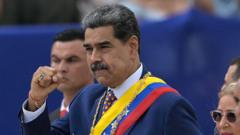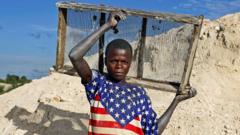A recent report reveals sweeping reductions to U.S. foreign aid, including critical vaccine funding, while some support for H.I.V. and tuberculosis treatment remains, raising concerns about public health in developing countries.
U.S. Aid Shift: Trump Administration Cuts Vaccine Support for Developing Nations

U.S. Aid Shift: Trump Administration Cuts Vaccine Support for Developing Nations
The Trump administration plans significant cuts to foreign aid programs, impacting global health initiatives.
In a bold but controversial shift, the Trump administration has outlined plans to terminate U.S. financial support for Gavi, an organization that has played a pivotal role in providing vaccines to children in developing nations. This reduction in funding has the potential to reverse decades of progress in child health and safety, as it significantly curtails access to vaccines that have historically saved millions of lives globally.
According to a detailed spreadsheet obtained by the New York Times—that was sent to Congress by the United States Agency for International Development (U.S.A.I.D.)—the administration's foreign aid strategy will see the continuation of certain grants focused on combating H.I.V. and tuberculosis, as well as providing food aid to regions facing civil unrest and natural disasters. However, this represents a stark departure from the U.S.'s previous role as a leader in global health interventions.
The cover letter accompanying the spreadsheet indicates that the cuts have left U.S.A.I.D. dramatically diminished, with funding severely reduced and a workforce greatly diminished—only 869 of over 6,000 employees remain on active duty following these changes. The data presented shows the continuation of 898 U.S.A.I.D. awards, while an alarming 5,341 awards are set to be ended. The letter estimates that the remaining programs could be valued at up to $78 billion, yet only a fraction—approximately $8.3 billion—represents funds that are readily available for disbursal.
Given the historical context, the cuts represent a significant retreat from a half-century commitment by the U.S. to advocate for the health and prosperity of vulnerable populations worldwide. As the global community grapples with various health crises, the uncertainty surrounding the future of U.S. foreign aid introduces critical questions regarding the effectiveness of existing health frameworks and how vulnerable populations will be supported moving forward.
According to a detailed spreadsheet obtained by the New York Times—that was sent to Congress by the United States Agency for International Development (U.S.A.I.D.)—the administration's foreign aid strategy will see the continuation of certain grants focused on combating H.I.V. and tuberculosis, as well as providing food aid to regions facing civil unrest and natural disasters. However, this represents a stark departure from the U.S.'s previous role as a leader in global health interventions.
The cover letter accompanying the spreadsheet indicates that the cuts have left U.S.A.I.D. dramatically diminished, with funding severely reduced and a workforce greatly diminished—only 869 of over 6,000 employees remain on active duty following these changes. The data presented shows the continuation of 898 U.S.A.I.D. awards, while an alarming 5,341 awards are set to be ended. The letter estimates that the remaining programs could be valued at up to $78 billion, yet only a fraction—approximately $8.3 billion—represents funds that are readily available for disbursal.
Given the historical context, the cuts represent a significant retreat from a half-century commitment by the U.S. to advocate for the health and prosperity of vulnerable populations worldwide. As the global community grapples with various health crises, the uncertainty surrounding the future of U.S. foreign aid introduces critical questions regarding the effectiveness of existing health frameworks and how vulnerable populations will be supported moving forward.






















